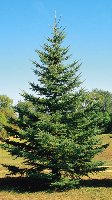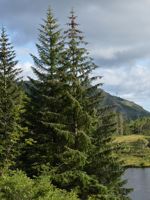Mon-Fri 9am - 5pm Mountain time
Black Hills Spruce vs Sitka Spruce
Picea glauca var. densata
Picea sitchensis
CUSTOM GROW
Black Hills Spruce is a subspecies of White Spruce native to the Black Hills of South Dakota. It has a strongly conical form, slower growth rate and denser foliage than typical white spruce, making it preferable as a specimen tree for smaller suburban lawns. It also responds well to pruning, and can be used as a hedge or even bonsai.
Sitka Spruce is a native conifer and the largest spruce species in the world. It grows quickly and reaches impressive heights, often reaching more than 50 metres (164 feet) in suitable conditions. It has strong, durable wood that has long been recognised for its commercial value.
It contributes to soil stability and plays an important role in coastal ecosystems. It offers cover and nesting sites for birds and small animals, and its seeds provide food for wildlife such as songbirds and small mammals.
Sitka Spruce plays a role in reforestation and ecological restoration projects in Coastal BC. It also holds historical significance: the Wright Brothers famously used Sitka Spruce to construct the frames of their first flying machines.
Black Hills Spruce Quick Facts
Sitka Spruce Quick Facts
In row spacing: 3 - 4 m (10 - 12 ft)

